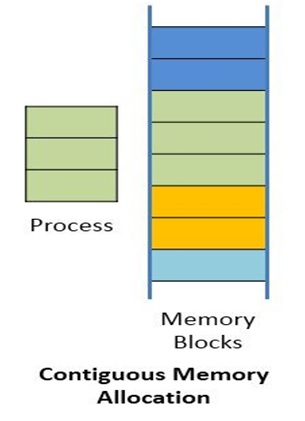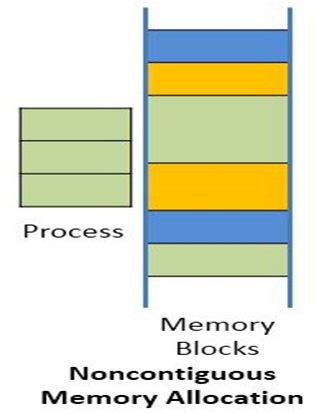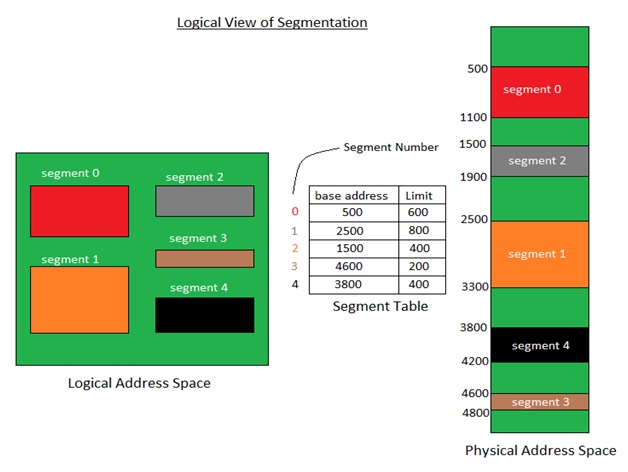Continuous Vs Non Continuous Storage Cs
Home » Operating Systems
Contiguous and Non-Contiguous memory allocation in Operating System
Here, we are going to learn about the Contiguous and Non-Contiguous memory allocation in Operating System and what are the differences between them?
Submitted by Prerana Jain, on April 23, 2019
In this article, we will learn about the different types of memory management techniques and also the pros and cons of different memory management techniques.
Memory management
Memory is central to the operation of a computer system. It consists of a large array of words or bytes each with its own address. In uniprogramming system, main memory has two parts one for the operating system and another part is for the program currently being executed. In the multiprogramming system, the memory part of the user is further divided into accommodate processes. The task of the subdivision is cannot out by the operating system and is known as memory management.
Memory management techniques
The memory management techniques is divided into two parts...
- Uniprogramming:
In the uniprogramming technique, the RAM is divided into two parts one part is for the resigning the operating system and other portion is for the user process. Here the fence register is used which contain the last address of the operating system parts. The operating system will compare the user data addresses with the fence register and if it is different that means the user is not entering in the OS area. Fence register is also called boundary register and is used to prevent a user from entering in the operating system area. Here the CPU utilization is very poor and hence multiprogramming is used. - Multiprogramming:
In the multiprogramming, the multiple users can share the memory simultaneously. By multiprogramming we mean there will be more than one process in the main memory and if the running process wants to wait for an event like I/O then instead of sitting ideal CPU will make a context switch and will pick another process.- Contiguous memory allocation
- Non-contiguous memory allocation
a) Contiguous memory allocation
In contiguous memory allocation, all the available memory space remain together in one place. It means freely available memory partitions are not scattered here and there across the whole memory space.
In the contiguous memory allocation, both the operating system and the user must reside in the main memory. The main memory is divided into two portions one portion is for the operating and other is for the user program.
In the contiguous memory allocation when any user process request for the memory a single section of the contiguous memory block is given to that process according to its need. We can achieve contiguous memory allocation by dividing memory into the fixed-sized partition.
A single process is allocated in that fixed sized single partition. But this will increase the degree of multiprogramming means more than one process in the main memory that bounds the number of fixed partition done in memory. Internal fragmentation increases because of the contiguous memory allocation.

→ Fixed sized partition
In the fixed sized partition the system divides memory into fixed size partition (may or may not be of the same size) here entire partition is allowed to a process and if there is some wastage inside the partition is allocated to a process and if there is some wastage inside the partition then it is called internal fragmentation.
Advantage: Management or book keeping is easy.
Disadvantage: Internal fragmentation
→ Variable size partition
In the variable size partition, the memory is treated as one unit and space allocated to a process is exactly the same as required and the leftover space can be reused again.
Advantage: There is no internal fragmentation.
Disadvantage: Management is very difficult as memory is becoming purely fragmented after some time.
b) Non-contiguous memory allocation
In the non-contiguous memory allocation the available free memory space are scattered here and there and all the free memory space is not at one place. So this is time-consuming. In the non-contiguous memory allocation, a process will acquire the memory space but it is not at one place it is at the different locations according to the process requirement. This technique of non-contiguous memory allocation reduces the wastage of memory which leads to internal and external fragmentation. This utilizes all the free memory space which is created by a different process.

Non-contiguous memory allocation is of different types,
- Paging
- Segmentation
- Segmentation with paging
i) Paging
A non-contiguous policy with a fixed size partition is called paging. A computer can address more memory than the amount of physically installed on the system. This extra memory is actually called virtual memory. Paging technique is very important in implementing virtual memory. Secondary memory is divided into equal size partition (fixed) called pages. Every process will have a separate page table. The entries in the page table are the number of pages a process. At each entry either we have an invalid pointer which means the page is not in main memory or we will get the corresponding frame number. When the frame number is combined with instruction of set D than we will get the corresponding physical address. Size of a page table is generally very large so cannot be accommodated inside the PCB, therefore, PCB contains a register value PTBR( page table base register) which leads to the page table.
Advantages: It is independent of external fragmentation.
Disadvantages:
- It makes the translation very slow as main memory access two times.
- A page table is a burden over the system which occupies considerable space.
ii) Segmentation
Segmentation is a programmer view of the memory where instead of dividing a process into equal size partition we divided according to program into partition called segments. The translation is the same as paging but paging segmentation is independent of internal fragmentation but suffers from external fragmentation. Reason of external fragmentation is program can be divided into segments but segment must be contiguous in nature.
iii) Segmentation with paging
In segmentation with paging, we take advantages of both segmentation as well as paging. It is a kind of multilevel paging but in multilevel paging, we divide a page table into equal size partition but here in segmentation with paging, we divide it according to segments. All the properties are the same as that of paging because segments are divided into pages.

Source: https://www.includehelp.com/operating-systems/contiguous-and-non-contiguous-memory-allocation.aspx
0 Response to "Continuous Vs Non Continuous Storage Cs"
Post a Comment